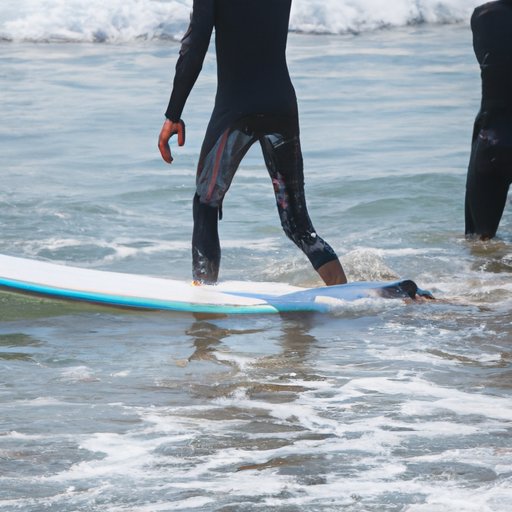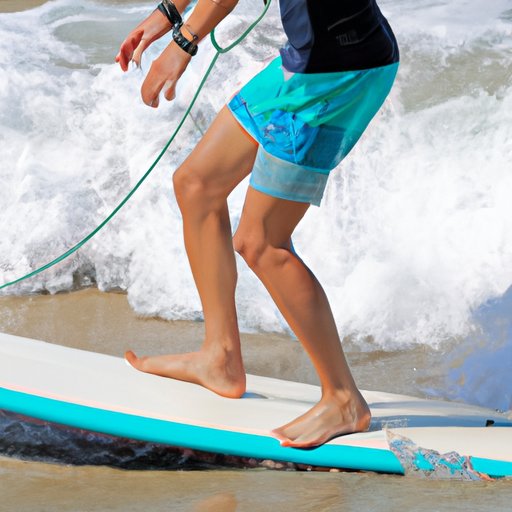Introduction
If you’ve always dreamed of catching the perfect wave, but don’t know where to start, you’ve come to the right place! This article will cover everything you need to know to start surfing, including basic techniques, safety advice, surfboard maintenance, and much more. Whether you’re a complete beginner or an experienced surfer looking to improve your skills, you’ll find all the information you need here.
Mastering the Basics: A Beginner’s Guide to Surfing
Before you hit the waves, it’s important to know the basics of surfing. Here are a few essential techniques to get you started:
Equipment needed for surfing
Surfing requires some basic equipment, including a surfboard, leash, wetsuit, and wax. Choose a board that is appropriate for your skill level, and make sure you have the right size wetsuit for the water temperature.
How to position yourself on the board
When you’re lying on your board, make sure your weight is centered in the middle of the board. Your head should be lifted slightly off the board, and your feet should be close together near the tail of the board.
How to paddle
To paddle, lie down on the board and use your hands to pull the water towards your body. Keep your elbows above the board and use your core muscles to stay stable.
How to stand up on the board
When you see a wave approaching, paddle towards it and then pop up onto your feet in one fluid motion. Keep your knees bent and your body centered over the board to maintain balance.
Tips for staying balanced on the board
Once you’re standing on the board, keep your weight centered and your gaze fixed on the horizon. Use your arms and core muscles to make small adjustments as you ride the wave.
Preparing to Catch a Wave: Tips and Techniques for Novice Surfers
When you’re ready to catch a wave, there are a few key techniques to keep in mind:
How to choose the right wave
Look for a wave that is breaking evenly and steadily. Avoid waves that are too big or too steep for your level of experience.
When to start paddling
Start paddling when you see a wave that is starting to break behind you. You want to build up enough speed to catch the wave before it passes you by.
How to time your pop up
Timing is everything when it comes to popping up on your board. As the wave starts to lift you up, take a deep breath and smoothly push up with your arms and legs to stand up on the board.
Tips for catching your first wave
Don’t be discouraged if you miss your first few waves. Keep practicing, and remember to stay relaxed and focused. With time and patience, you’ll be cruising along on your board in no time.
Stay Safe While Surfing: Essential Surfing Etiquettes and Safety Measures
Safety should always be your top priority when surfing. Here are a few key tips to keep in mind:
Explanation of surfing etiquettes
Surfing has its own set of unwritten rules, such as not dropping in on other surfers’ waves and giving right of way to the surfer nearest to the peak. Learn these rules and respect the other surfers in the water.
Safety measures to take before entering the water
Before you hit the waves, make sure you’re prepared for the conditions. Check the weather forecast, wear a wetsuit that fits properly, and make sure your equipment is in good condition.
Tips for avoiding collisions with other surfers
Stay alert and aware of other surfers in the water. Communicate with other surfers if you’re sharing a wave, and make sure you’re not paddling in the paths of other surfers.

From the Beach to the Board: What to Expect During Your First Surfing Lesson
Even if you feel confident in your surfing abilities, it’s always a good idea to take lessons from a qualified instructor. Here’s what you can expect from your first lesson:
Importance of taking surfing lessons from a qualified instructor
A qualified instructor can teach you proper technique and safety measures, as well as help you choose the right equipment for your skill level.
Explanation of what to expect during your first surfing lesson
Your first lesson may involve some time on the beach practicing techniques, as well as time in the water practicing your skills. Your instructor will be with you every step of the way to ensure your safety and help you improve your technique.
Tips for getting the most out of your first lesson
Come to your lesson with a positive attitude and willingness to learn. Listen carefully to your instructor’s advice, ask questions if you’re unsure, and don’t be afraid to make mistakes.
Maintaining Surfboards: A Comprehensive Surfboard Care Guide
Proper maintenance is key to keeping your surfboard in good condition and extending its lifespan. Here’s what you need to know:
Importance of proper surfboard maintenance
A well-maintained surfboard will perform better and last longer than a board that’s been neglected.
How to properly clean your surfboard
Use a mild detergent and warm water to clean your board after each use, and be sure to rinse it thoroughly to remove any salt and sand.
Tips for maintaining the shape of your surfboard
Store your board in a cool, dry place, and avoid leaving it in direct sunlight for extended periods of time. Make any necessary repairs as soon as possible to avoid further damage.
Learning to Ride the Waves: Surfing Techniques for Intermediate and Advanced Surfers
Once you’ve mastered the basics, it’s time to take your skills to the next level. Here are a few techniques to help you ride the waves like a pro:
How to improve your turning ability
Practice shifting your weight and using your arms to turn the board. Keep your eyes focused on where you want to go and use your hips to help steer the board.
How to generate speed on the board
As you’re riding a wave, use your weight and your arms to generate speed. Pumping your legs can also help you pick up speed.
Tips for maneuvering through the waves
Learn to read the waves and position yourself to catch the best ones. Practice your timing and pay attention to other surfers in the water.
Surfing Destinations: The Best Places to Catch a Wave Around the World
If you’re looking for the ultimate surfing experience, check out these top surfing destinations:
Overview of surfing destinations in different continents
From California to Bali to Australia, there are incredible surfing destinations all over the world.
Explanation of what makes each destination unique for surfing
Some destinations offer huge waves for experienced surfers, while others have gentle waves that are perfect for beginners. Research local conditions and choose a destination that’s right for you.
Tips for planning a surfing trip to each destination
Plan ahead and book accommodations and activities in advance. Bring all the necessary gear, and make sure you’re prepared for the weather and conditions.
Conclusion
Whether you’re a complete beginner or an experienced surfer, there’s always more to learn about this exciting sport. From mastering the basics to exploring new surf destinations, the tips and techniques in this guide will help you improve your skills and stay safe in the water. So grab your board and get ready to catch some waves!
Are you ready to hit the waves? With patience and practice, anyone can learn to surf.
